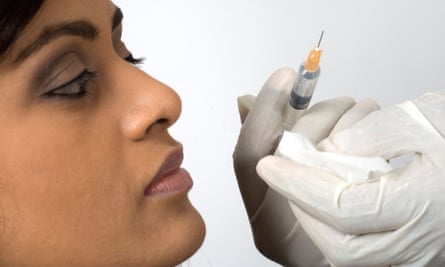From trout pouts to frozen foreheads, we’ve all seen people who look a bit odd after overdoing the Botox or facial fillers. Then there are the horror stories of people left blinded or with festering wounds after botched cosmetic injections.
The market for non-surgical cosmetic treatments is booming; the desire for plump, youthful-looking skin or the perfect “Instagram face” apparently trumping any fears of bad results or medical complications. Injections of botulinum toxin and dermal fillers are now the most common non-surgical cosmetic procedures worldwide, and the market for such “tweakments” is anticipated to grow a further 15.4% by 2030.
Advocates insist it is possible to get work done safely with beautiful results. But recent research is prompting some doctors to question how much we really know about the long-term effects of such injectable enhancements, and as their popularity continues to grow, regulators are weighing how best to keep people safe.
Dermal fillers are gel-like substances used to fill lines and wrinkles and plump up areas such as cheeks or lips. They have been in use since the 1970s when bovine collagen started being injected into people’s faces, but they really took off in the early 2000s, when the first fillers based on hyaluronic acid – a water-attracting substance found throughout the human body – were approved.
At around the same time, botulinum toxin injections – the best known brand being Botox – also started being used cosmetically, after years of use treating muscle spasms. These work by temporarily relaxing the facial muscles they’re injected into, helping to smooth out crow’s feet, frown lines and wrinkles.
In the early days, such treatments were predominantly the closely guarded secret of older women seeking a discreet solution to ageing skin. Increasingly though, younger women (and men) are using them to enhance their features, inspired by social media and reality TV show contestants.
“Since Love Island, it seems that having bigger lips has become just a kind of rite of passage for enormous numbers of young women,” says Alice Hart-Davis, a beauty journalist and founder of The Tweakments Guide, which aims to help people make informed decisions about such procedures.
Tracking the boom in these treatments has been a rise in medical complications and complaints about botched jobs. Save Face, a UK register of accredited cosmetic practitioners that campaigns for improved safety standards, says it received 2,824 complaints during 2022 – up from 2,436 in 2021 and 2,083 in 2020. More than two-thirds of these related to dermal fillers and almost a quarter to Botox-like treatments.
Save Face director Ashton Collins believes these figures are reflective of the sheer number of filler procedures that are occurring, as well as the nature of the injections – which in inexpert hands can result in infections, blocked blood vessels and tissue death, or work that simply looks lumpy or overdone.
“In safe, expert hands the risk of any of those complications is minimised considerably, and if they did occur, the practitioner would have the expertise to identify the signs really early on and manage them effectively. But because anybody and everybody is now doing these treatments, we’ve seen a huge increase in the number of complications,” Collins says.
Some of these complications can be life-changing. “We’ve had patients who’ve had quite a large area of skin die on their face, because the blood vessel supplying it was occluded by malplacement of filler,” says Dr David Zargaran, a plastic surgery registrar at London’s Royal Free hospital.
Although hyaluronic acid-based fillers can be dissolved by injecting an enzyme called hyaluronidase, these aren’t the only fillers on the market, and patients don’t always know what they’ve been injected with. Of the complaints registered by Save Face, 82% of people didn’t know what product their therapist had used.

Even if it is a dissolvable filler, time is of the essence: “Unfortunately, in quite a lot of cases, patients tend to present quite late, and whilst you can still try, you may not be able to reverse the damage,” Zargaran says. For such patients, reconstructive surgery is their only recourse.
Compounding the problem are poorly-qualified therapists who refuse to take customers’ concerns seriously. Of the complaints received by Save Face last year, 84% of people claimed that they were ignored or blocked by their practitioner when they tried to seek help.
Collins says: “We had one girl who was literally hours away from having to have her lips surgically removed, because the filler was blocking the blood supply. The person who treated her kept telling her it was a bruise and would go away, but obviously it didn’t. Luckily, she didn’t have to have that surgery, but it was it was very touch and go for a while.”
Witnessing such complications prompted Zargaran to start investigating who was carrying out these cosmetic procedures. Together with colleagues at University College London, he evaluated the websites of 3,000 UK aesthetic clinics, cross-checking their practitioners with professional bodies such as the General Medical Council and the Nursing and Midwifery Council. Doing so revealed that 32% were doctors, while 24% were dentists, 13% nurses, 12% beauticians and 8% dental nurses. However, this study only examined practitioners who were affiliated to a clinic; many others advertise their services on social media, and carry out treatments in their own homes – or even in the back of cars.
“I think fundamentally, it comes down to competence,” says Zargaran. “If you’re competent to properly consent the patient, to administer the intervention cognisant of the risks and potential pitfalls, and at least able to recognise potential complications, and if possible, treat them, that is a step in the right direction.
“The challenge we have is that many individuals undertake limited educational courses where they attend for one or two days, and this provides the basis on which they get insurance to practice independently. Some people don’t even have insurance, which just speaks to the lack of robust regulation in this sector.”
While most experts agree that botulinum toxin injections tend to be safer – particularly as the effects of poorly administered injections usually wear off after three to four months – there are concerns that practitioners aren’t reporting all of the side-effects experienced by customers. This makes it hard to know what the real-life complication rates of such procedures are, Collins says.
When Zargaran’s team conducted a review of the medical literature relating to botulinum toxin injections, they found that issues such as bruising, headaches, nausea and “frozen” features affected around one in six users. Yet even though an estimated 900,000 Botox-like injections are carried out in the UK each year, just 188 adverse reactions had been reported to Britain’s medicines regulator the MHRA in the preceding 29 years.
READ RELATED: Louise Thompson bravely shares her ‘catastrophic breakdown’ on Instagram
Botulinum toxins are a prescription-only product, meaning that by law they should only be injected following a face-to-face meeting with a qualified medical practitioner such as a doctor, dentist, pharmacist or nurse prescriber. While this should mean that injectors have a sound knowledge of anatomy and how to handle adverse reactions, the prescriber isn’t always the person doing the injections.
There are plenty of therapists who will perform injections without offering a medical consultation. “Instead, they work with somebody who is willing to [prescribe] the products without seeing the patient, or more worryingly, we’re seeing a big increase in people buying cheap botulinum toxins on the internet, where they don’t actually know what’s in it,” says Collins. “We’ve seen some horrific cases where people have injected with what they believed was Botox, but turned out to be beef gelatin – causing some of them to have really serious anaphylactic reactions.”
Of the people who complained to Save Face about Botox-like procedures last year, 92% said they did not have a face-to-face consultation with a licensed prescriber and, based on the side-effects they reported or their practitioners’ unwillingness to supply further information, more than 20% of these cases are believed to have involved unlicensed or counterfeit products, Collins said.
Scary as all of this sounds, there are plenty of reputable practitioners out there, not to mention satisfied customers, Hart-Davis being one of them: “People often say to me, ‘I’ve never seen good work done with dermal fillers,’ and I say, ‘You absolutely have – but you won’t notice it if it’s good.’ I think people were really shocked when I recently wrote about how much filler there was in my face.”
Collins also admits to having had various treatments: “Because I seek out a really good healthcare professional, I have never had any complications – only positive experiences,” she says.
Earlier this month, the UK government launched a consultation on how to make non-surgical cosmetic procedures safer, ahead of a planned new licensing scheme. This could include restricting who can perform certain high-risk procedures, or introducing age limits for those undergoing treatments.
Yet, even in a capable pair of hands, do we really know enough about the long-term impact of such procedures to be sure they are safe?
Dr Gavin Chan is a cosmetic doctor and the founder of the Victorian Cosmetic Institute, in Victoria, Australia. Having spent much of his career injecting dermal fillers, a few years ago he began to notice some of his patients returning with puffiness around their eyes, having been injected five to seven years before.
This was odd, because hyaluronic acid-based fillers supposedly only last up to 18 months. Wondering what the cause of this puffiness might be, Chan referred some of them for an MRI scan with his colleague Dr Mobin Master. “Pretty much all the cases showed the presence of filler persisting for many years, rather than just for the six to 18 months we expected,” Chan says.
Further investigations – which included Master injecting his own face with filler and following what happened to it over time – have shed additional light on the issue: “We found that the filler sort of smudges – it doesn’t move to another part of the face, but it spreads, a bit like an ice block melting – so what was once defined becomes a bit undefined and blurred,” says Chan. “It gives you a completely different perspective on how you’d inject these products. If you’re injecting a temporary filler, whatever side-effects you’re going to get will eventually go away. But it’s a completely different mindset with something that lasts 10 years plus, which is what we’re seeing on the MRI.”
There’s another issue weighing on his mind. Usually, people love the plump definition filler that provides in the weeks and months after it is first injected. Once this wears off, they often seek another treatment, and then maybe another. “The whole thing has this this addictive element to it,” says Chan. “Before you know it, these patients end up with a huge degree of overfilling, and they don’t even recognise it.
“The problem is that these people are reluctant to dissolve any of their fillers, because they’re scared to go back to a normal state, and if you do dissolve them, they get into a massive state of panic believing that the [procedure] has destroyed them. Once you’ve crossed that line into the overfilling stage, it is really hard to get any degree of normality back.”
The possibility of people becoming addicted to such treatments is beginning to worry other researchers as well. Prof David Veale, at the South London and Maudsley NHS Trust, and his colleagues recently carried out a study assessing the motivations of 24 women who had undergone lip filler procedures that had left them with dramatically overinflated lips, and who claimed to be happy with the results. The researchers were concerned was that such procedures might be fuelling body dysmorphic disorder – an anxiety disorder related to body image.
The study, published in Aesthetic Surgery Journal, identified several common themes: one was women having been repeatedly exposed to images of large lips on Instagram, and becoming increasingly dissatisfied with their natural lip shape within a relatively short space of time. Another was struggling with more generalised anxieties about body and appearance. This may predispose women towards seeking easily accessible, instantly gratifying cosmetic procedures, the researchers suggested.
Curiously, whereas some of the women reported getting positive comments about their lip fillers on social media, this didn’t always translate into the real world, where people sometimes suggested that they looked bad, or should avoid getting any more filler, yet they continued doing it. “In addiction psychiatry, we would describe this as continued use, despite being aware of harm, which is one feature of addictive behaviour,” says Dr Chloe Saunders, a psychiatry registrar and PhD student at Aarhus University in Denmark, who co-authored the study. “There was also this compulsive aspect of it – feeling very compelled to do the thing, but not being satisfied once they’d done it and wanting to do it again.”
Some described chasing the “buzz” they got from having these procedures; lying to aesthetic practitioners to get larger filler volumes or more frequent jabs; and wishing to cut down or stop lip filler use but struggling to do so.
Obviously, not everyone will become addicted to having fillers or other tweakments, but it it is important for practitioners and clients to be aware of this issue, and to the possibility of “perception drift” – where a person’s perception of their appearance gradually changes over a series of treatments, prompting them identify other “flaws” they want fixing.
Inspired by Chan’s MRI studies, Hart-Davis had her own face scanned, and discovered significant amounts of filler across her cheeks, jawline, chin, under her eyes, and in her nose-to-mouth lines and lips – despite barely having had any injected during the previous four years.
This hasn’t necessarily put her off having more injected in the future, but “it has reaffirmed my conviction that you really do need to get it done by the best person you can possibly find and afford,” she says. “Mine are all in the right place, exactly where they were put – albeit possibly quite a long time ago – and I am pretty convinced they are not doing me any harm. However, practitioners should not routinely book people back in for a six-month top-up, because they may well not need it.”
Her advice for anyone considering going under the needle is to do their homework first. “Find out as much as you can about the treatment you’re contemplating and then find a really good practitioner and check them out. Don’t just go to them because they’ve got a fancy Instagram account,” she says.



